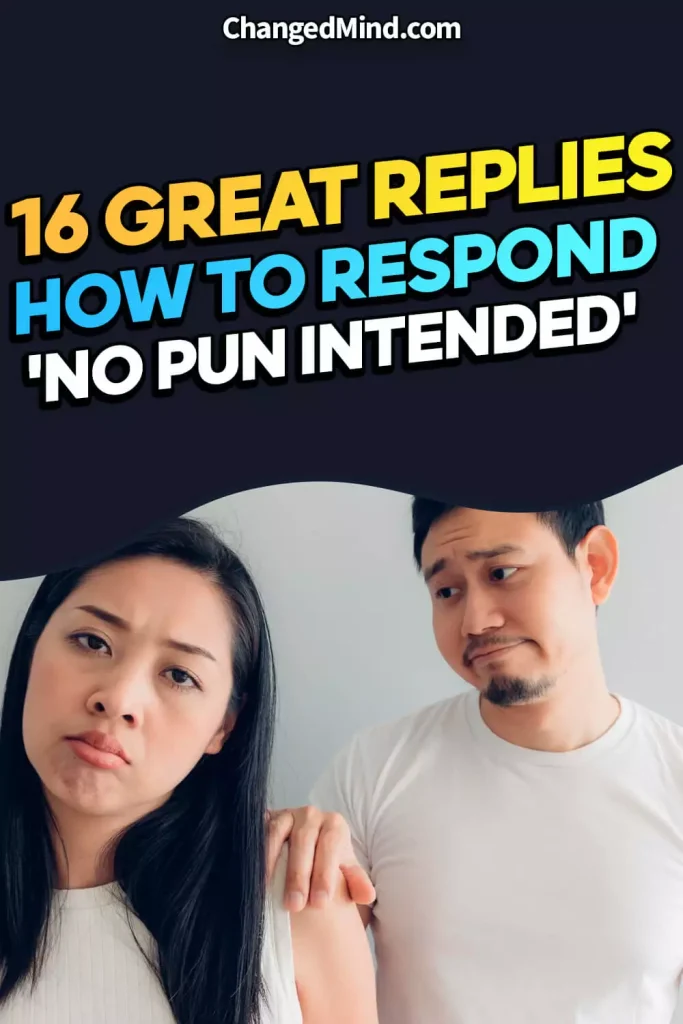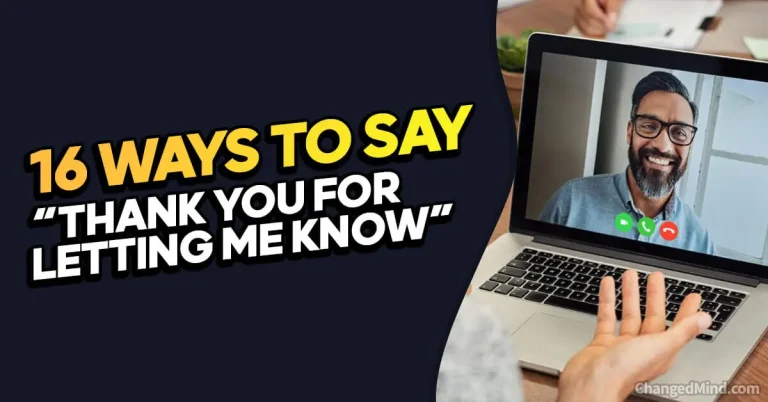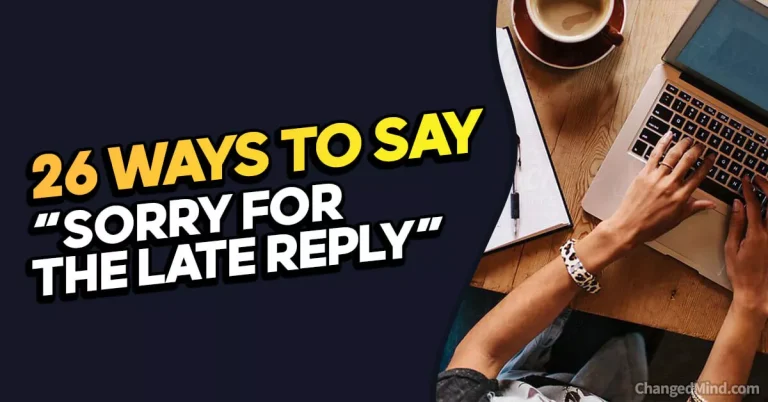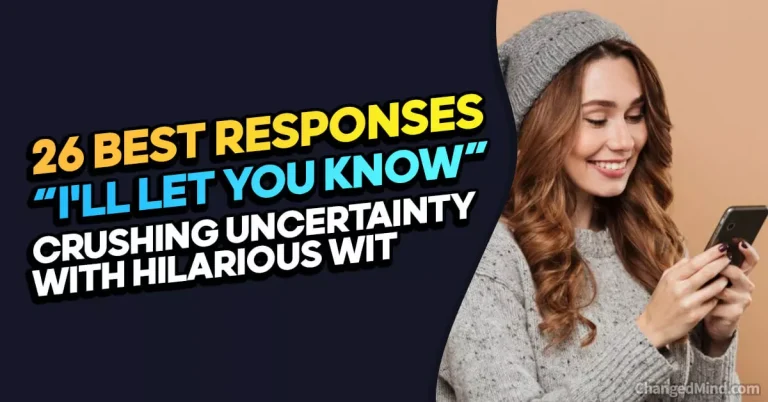Stuck on how to respond when someone says “No pun intended”? It’s not always easy to come up with a witty reply on the spot, but our guide will make you a pun-master in no time.
We’ll take you through 16 creative ways on how to respond to ‘No Pun Intended’ that’ll have everyone impressed with your quick wit. From humor-infused comebacks to clever retorts, we’ve got you covered. So, are you ready to become the pun-repartee champion?
Key Points to Discuss:
- Understanding the use of ‘No Pun Intended’
- 16 engaging responses to ‘No Pun Intended’
- Crafting witty and clever comebacks
- Guidelines for appropriate responses
- Enhancing conversational skills with puns
Understanding the Phrase “No Pun Intended”
The phrase “No Pun Intended” is often used when someone unintentionally makes a play on words or makes a statement that could be interpreted as a pun. It implies that the person did not intend for the statement to be humorous or clever, but it ended up being so. It is a way of acknowledging the unintentional wordplay.
What Does “No Pun Intended” Mean?
“No Pun Intended” is a phrase used to indicate that a pun was unintentionally made. It is a way of clarifying that the speaker did not intentionally make a joke or play on words, but it happened naturally in their statement.
How Should You Respond to “No Pun Intended”?
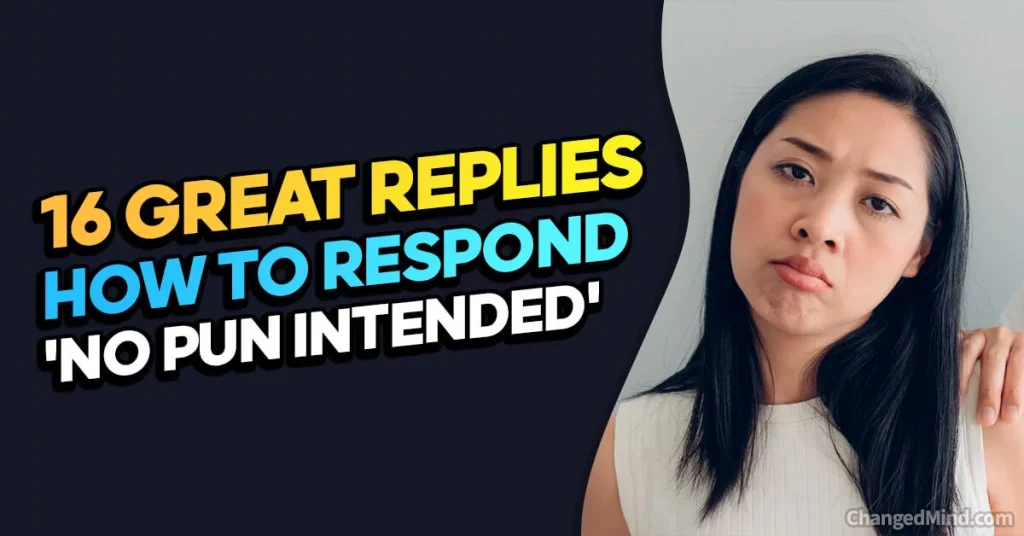
When someone says “No Pun Intended,” there are several ways you can respond to acknowledge the unintentional pun and appreciate the humor:
- Acknowledge the Pun: Simply acknowledge the pun by saying something like, “Nice one!” or “That was a clever wordplay.”
- Appreciate the Humor: Respond by showing your appreciation for the unintentional pun, such as saying, “Haha, that was funny!” or “I love a good unintended pun!”
- Respond with a Counter Pun: If you’re feeling playful, respond with a counter pun of your own that relates to the situation. This can lead to a lighthearted exchange of wordplay.
- Laugh and Show Amusement: Respond with genuine laughter and show that you find the pun amusing. This encourages the person to feel comfortable with their unintentional joke.
- Respond with a Playful Remark: Make a playful remark about the unintentional pun. This can be something like, “You should consider a career in comedy!” or “Who knew you were a secret wordsmith?”
What If You Don’t Understand the Pun?
If you don’t understand the pun being made, it’s okay to ask for clarification or simply smile and move on. Not every pun is immediately obvious, and it’s better to show genuine interest in understanding rather than pretending to get it.
When Should You Avoid Using “No Pun Intended”?
It’s important to use “No Pun Intended” in appropriate situations. Avoid using it if the pun may cause offense or be inappropriate in the context of the conversation. Be mindful of the sensitivity of others and choose your words wisely.
By understanding the phrase “No Pun Intended” and knowing how to respond to unintentional puns, you can engage in humorous exchanges and appreciate the cleverness of language.
Key takeaway:
- Understanding the phrase “No Pun Intended”: It is important to grasp the meaning behind the phrase “No Pun Intended” to effectively respond to it.
- Appreciating the humor: Responding by acknowledging and appreciating the pun shows a sense of humor and fosters a positive interaction.
- Responding playfully: Counter puns, laughter, and playful remarks can be used to respond to “No Pun Intended” and further engage in a humorous conversation.
Understanding the Phrase “No Pun Intended”
Understanding the phrase “No Pun Intended” is crucial for effective communication and avoiding potential misunderstandings. This commonly used phrase is typically employed in situations where a speaker unintentionally makes a pun or wordplay. Acknowledging this unintentional wordplay helps to clarify that the speaker did not intend for it to be humorous or clever. By comprehending the meaning behind “No Pun Intended,” we can navigate conversations more effectively.
Here are some key points to consider when comprehending the phrase “No Pun Intended“:
- Context matters: We should always consider the context in which the phrase is used. It is essential to analyze the words that precede or follow the phrase to fully understand the speaker’s intention.
- Clarity of meaning: The phrase “No Pun Intended” indicates that the speaker did not intend to make a joke or wordplay. It is used as a disclaimer to emphasize that any coincidental humorous or clever aspect of their statement was unintentional.
- Respect for the speaker: When someone uses the phrase “No Pun Intended,” it is important to acknowledge their intention and give them the benefit of the doubt. This phrase helps to cultivate a respectful communication environment by avoiding unnecessary misunderstandings or hurt feelings.
- Active listening: While it’s crucial to understand the meaning behind “No Pun Intended,” it is equally important to actively listen to the speaker’s overall message. Focusing solely on whether a pun was intended could distract from the main point being made.
Remember that understanding the phrase “No Pun Intended” allows for smoother and more effective communication while maintaining respect for the speaker’s intentions.
Pro tip: If you find yourself unintentionally making a pun, consider using the phrase “No Pun Intended” to clarify your intention and avoid any unintended humor. By doing so, you demonstrate self-awareness and actively work towards clear and respectful communication.
What Does “No Pun Intended” Mean?
“No pun intended” is a phrase that clarifies when a statement is not meant to be a play on words or a joke. It is commonly used when someone accidentally says something that may have a humorous or ironic double meaning.
Here are a few key points to understand about this phrase:
- Literal Meaning: The phrase “no pun intended” is used to clarify that a pun or wordplay was not intended in a previous statement. It is often added after unintentionally making a statement that could be interpreted as a pun.
- Acknowledging Coincidence: When used, “no pun intended” acknowledges the coincidence of a potentially humorous or ironic double meaning. It shows that the statement was not deliberately crafted to create a pun.
- Common Usage: “No pun intended” is frequently used in conversation, writing, and media to prevent misunderstandings and assure that the speaker or writer did not intend to make a joke or wordplay.
- Humorous Undertone: Although it is used to indicate the absence of intentional wordplay, “no pun intended” can sometimes add a humorous undertone to a statement as it draws attention to a potential pun that was not intended.
Fact: The term “pun” originated from the Latin word “punctum,” meaning “point.” In the 17th century, it was used to refer to a literary device where multiple meanings of a word or phrase are cleverly used for humorous or rhetorical effect.
16 ways of How to Respond to ‘No Pun Intended’
1. Well, I’m ‘pun-der’ impressed!: A playful pun-filled reply.
2. Too late, I’m already laughing!: A cheerful acknowledgment.
3. No pun intended, but you’re ‘pun-believably’ good!: Complimenting them with a pun.
4. There it is, the ‘pun-chline’!: An enthusiastic response acknowledging their pun.
5. That was ‘pun-expected’!: A humorous, pun-based surprise reaction.
6. Guess you just couldn’t ‘pun-tain’ yourself!: A playful tease about their use of puns.
7. Intended or not, that was ‘pun-derful’!: A positive response appreciating their humor.
8. Wow, you really ‘pun-etrated’ the conversation there!: Acknowledging their pun in a fun way.
9. And here I thought you were ‘pun-stop-able’!: A light-hearted comment on their frequent use of puns.
10. You’re a ‘pun-disputed’ champion!: Complimenting their ability to make puns.
11. Puns are ‘pun-intentional’ fun, aren’t they?: An encouraging response.
12. I ‘pun-derstand’, no explanation needed!: A pun-filled acknowledgment.
13. Pun or no pun, that was funny!: A straightforward and appreciative response.
14. Couldn’t help yourself, huh? Puns are irresistible!: A friendly tease.
15. No pun intended? Too bad, it was ‘pun-outstanding’!: A response that compliments their humor.
16. Keep ’em coming, your puns are ‘pun-stop-ably’ good!: Encouraging more puns in the conversation.
How Should You Respond to “No Pun Intended”?

When someone drops a subtle pun with a mischievous grin and follows it up with the classic phrase “No pun intended,” how should you respond? Well, let’s dive into it!
In this section, we’ll explore different ways to handle this playful linguistic situation. From acknowledging the pun and appreciating the humor to responding with a clever counter pun or a lighthearted remark, we’ll uncover the art of navigating pun-filled conversations with grace and wit.
So, get ready to embrace the puns and unleash your playful side!
Acknowledge the Pun
When someone says “No Pun Intended,” it is crucial to Acknowledge the Pun and respond appropriately. Here is a table that outlines different ways to Acknowledge the Pun and effectively respond:
| Acknowledge the Pun | Response |
| The pun is understood and appreciated. | Recognize the pun and express amusement. For example, you can say, “That was a clever play on words!” |
| The pun is unexpected and catches you off guard. | Take a moment to process the pun and then respond with a lighthearted remark. For instance, you could say, “Nice one! Took me a second to catch on!” |
| The pun is unintentional or not clear. | Honestly admit that you didn’t catch the pun and ask for clarification. You can say, “I’m sorry, I didn’t quite get the pun. Could you explain it to me?” |
Remember, Acknowledging the Pun shows that you are attentive and engaged in the conversation. It also helps in keeping the humor flowing. Pro-Tip: If someone makes a pun and says “No Pun Intended,” respond with a smile and a witty remark to keep the conversation light-hearted and enjoyable.
Appreciate the Humor
Appreciating the humor is an essential part of responding to the phrase “no pun intended.” It shows that you understand and enjoy the clever wordplay or double meaning behind the statement. When someone uses this phrase, it indicates that they have made a pun unintentionally but find it amusing. Here’s how you can appreciate the humor in such situations:
1. Smile and nod: When someone says “no pun intended,” acknowledge their pun with a smile or a subtle nod. This non-verbal cue indicates that you appreciate the humorously intended wordplay.
2. Chuckle or laugh: If the pun is particularly witty or funny, let out a chuckle or laugh to show that you appreciate the humor. This response encourages the person to feel acknowledged for their unintentional yet clever wordplay.
3. Show amusement: Use facial expressions and gestures to express your amusement. A raised eyebrow, a grin, or even a playful clap can demonstrate your enjoyment of the pun.
4. Encourage further puns: If you are comfortable with wordplay and enjoy puns, you can respond with a playful remark or pun of your own. This interaction creates a lighthearted and humorous atmosphere, encouraging a friendly pun-filled exchange.
5. Share a similar experience: If you have encountered a similar situation where you unintentionally made a pun, share it with the person. This connection can lead to laughter and further appreciation of the humor.
Pro-tip: Remember, appreciating the humor in someone’s unintentional pun is a great way to bond and create a positive atmosphere. It shows that you are attentive, open to wordplay, and have a good sense of humor. So, next time you come across a “no pun intended,” show your appreciation and enjoy the witty moment!
Respond with a Counter Pun
If someone uses the phrase “no pun intended,” you can respond by acknowledging their pun and coming up with a clever counter pun. This playful exchange allows for a lighthearted and enjoyable moment.
- Start by acknowledging the pun made by the speaker. This shows that you understood their pun and are ready to respond with your own humorous twist.
- Create a witty response that includes a play on words or a humorous twist related to the original pun. This back-and-forth exchange of puns adds to the fun.
- Aim to elicit laughter and amusement from the listeners with your counter pun. This helps create a pleasant and enjoyable atmosphere.
- Showcase your quick wit and humor by using your creativity to come up with unique and unexpected wordplay. This impresses others and adds to the fun of the interaction.
- Maintain a playful tone throughout the exchange. This ensures that the interaction remains enjoyable and light-hearted for everyone involved.
Next time someone uses the phrase “no pun intended,” seize the opportunity to respond with a clever counter pun. It’s a fun way to engage in a humorous exchange and showcase your wit and creativity.
Remember, humor is subjective, so be mindful of the context and the person you are interacting with. Gauge the situation and the audience before responding with a counter pun. Not everyone appreciates puns, so choose your audience carefully.
Pro-tip: When responding with a counter pun, make sure it is appropriate and considerate. Avoid puns that may offend or hurt someone’s feelings. The aim is to create a light-hearted and enjoyable moment for everyone involved.
Laugh and Show Amusement
Laughing and showing amusement is a common response when someone says “no pun intended.” It is a way to acknowledge the intended humor and lighten the atmosphere of the conversation. Here are some ways to laugh and show amusement when faced with a pun:
1. Burst into laughter: Let out a genuine laugh to show that you found the pun amusing. This response can indicate that you appreciate the cleverness behind the pun.
2. Smile and chuckle: If the pun is more subtle or lighthearted, a warm smile and a light chuckle can demonstrate your amusement without being overpowering.
3. Give a playful clap: Clapping your hands lightly with a smile on your face can be a fun way to show that you enjoyed the pun and found it entertaining.
4. Make a witty comment: Responding with a quick and witty remark that plays along with the pun is another way to show that you appreciated it. This shows that you actively engaged with the humor and are able to respond in a clever manner.
Remember, the key is to respond in a positive and lighthearted manner. Laughing and showing amusement not only acknowledges the pun but also encourages the person who made the pun to continue being playful and funny. It helps create a jovial atmosphere and can lead to more enjoyable conversations.
So, the next time someone says “no pun intended,” let out a laugh, smile, or come up with a playful response to show that you found the pun amusing. It’s a great way to engage in the humor and connect with others through laughter.
Respond with a Playful Remark
Responding with a Playful Remark when someone says “no pun intended” can contribute to a lighthearted and humorous conversation. Here are some ways to playfully respond:
1. Play along with the pun: If you catch the pun and appreciate the humor, you can respond by acknowledging the pun and adding to the playful atmosphere. For example, you could say, “Well, puns do have a sneaky way of slipping in, intended or not!”
2. Twist the pun: Put your own creative spin on the pun by responding with a playful remark that adds a new twist to the conversation. For instance, you could say, “No pun intended? Don’t worry, I’m always up for an unintended pun-ishment!”
3. Use wordplay: Responding with a playful remark that incorporates wordplay can add a touch of wit to the conversation. For example, you could say, “No pun intended? Oh, come on, don’t be so pun-fair!”
4. Express amusement: Show your amusement and appreciation for the pun by responding with laughter. You could chuckle and say, “Well, puns have a way of surprising us, so I’ll take it as a delightful surprise!”
5. Embrace the playfulness: Respond with a humorous and lighthearted remark that embraces the playful nature of the situation. For instance, you could say, “No pun intended? Well, now you’re challenging me to come up with unintended puns, and I accept!”
Remember, responding with a playful remark should be done in good spirits and with the intention of adding to the enjoyable banter. It’s all about embracing the humor and creating a positive and amusing interaction.
What If You Don’t Understand the Pun?
If you find yourself in a situation where you don’t understand a pun, there are a few things you can do to help clarify its meaning:
- Ask for clarification: If someone makes a pun and you don’t understand it, simply ask them to explain it. Most people are happy to explain a pun and share a good laugh.
- Consider the context: Puns often rely on wordplay and play on multiple meanings of words. By considering the context in which the pun was made, you might be able to deduce its intended meaning.
- Break down the words: Puns often involve a clever play on words. Breaking down the words and analyzing their different meanings or sounds can help you understand the pun better.
- Look for visual cues: Sometimes, puns are accompanied by visual cues or gestures that can give you a hint about their meaning. Pay attention to these cues to help you understand the pun.
- Research: If all else fails, you can always do a quick search online. There are many resources available that explain different puns and their meanings. However, remember to use this option sparingly and only when necessary.
Understanding puns can sometimes be challenging, especially if the wordplay is complex or relies on cultural references. However, by employing these strategies, you can improve your ability to understand and appreciate puns.
When Should You Avoid Using “No Pun Intended”?
Using the phrase “No pun intended” can be a humorous way to acknowledge a pun in a sentence. However, there are certain situations where it is best to avoid using this phrase.
1. Formal settings: When communicating in formal settings, such as business meetings or professional emails, it is generally better to avoid using “No pun intended.” The phrase can come across as unprofessional and may undermine the seriousness of the discussion.
2. Sensitive topics: If you are discussing sensitive topics or issues that could be potentially offensive, it is important to be mindful of the impact of your words. Using “No pun intended” in such situations can trivialize or minimize the seriousness of the topic, and may be perceived as insensitive or disrespectful.
3. Cross-cultural communication: Different cultures have varying norms and conventions when it comes to humor. What may be funny in one culture could be completely inappropriate or offensive in another. When communicating with individuals from different cultural backgrounds, it is wise to err on the side of caution and avoid using “No pun intended” unless you are certain it will be understood and well-received.
4. Misunderstandings: Humor can be subjective, and there is always a risk that your pun may not be well-received or understood by the intended audience. Using “No pun intended” can draw attention to a pun that others may have missed, potentially causing confusion or awkwardness. In such cases, it is best to let the pun stand on its own and avoid drawing unnecessary attention to it.
5. Overuse: Like any other humorous phrase, using “No pun intended” too frequently can diminish its effect and make it seem forced or insincere. It is important to use it sparingly and only when the pun genuinely adds value to the conversation.
It is important to be mindful of the context, audience, and impact of using “No pun intended.” By considering these factors, you can make informed choices about when to use this phrase and when it is best to avoid it.
Some Facts About How to Respond to ‘No Pun Intended’:
- ✅ The phrase “no pun intended” is often used to apologize for unintentional jokes or puns. (Source: correctley.com)
- ✅ There are several possible responses to “no pun intended” including acknowledging the speaker’s intention, appreciating their wit, and showing understanding and forgiveness. (Source: correctley.com)
- ✅ Responding positively and respectfully to “no pun intended” can help create a light-hearted moment and maintain a positive relationship. (Source: correctley.com)
- ✅ It is important to show gratitude for the speaker’s consideration and respect when they use the phrase “no pun intended”. (Source: correctley.com)
- ✅ Responding with humor and appreciating the speaker’s effort can help diffuse any unintended offense caused by a pun. (Source: correctley.com)
Frequently Asked Questions
What does it mean when someone says “No pun intended”?
When someone says “No pun intended,” it means that they want to clarify that they did not intentionally make a play on words. A pun is a figure of speech that uses words with multiple meanings or similar sounds to create a joke. Saying “No pun intended” indicates that any play on words in their statement was unintentional.
How should I respond when someone says “No pun intended”?
It is important to respond respectfully and show understanding for the speaker’s intentions. Some possible responses include: “I understand, no worries,” “That’s ok, I get it,” or “I appreciate your discretion.” Use the opportunity to create a light-hearted moment and maintain a positive relationship.
Is it necessary to respond to “No pun intended” in a casual conversation?
While it is not mandatory, responding to “No pun intended” in a respectful manner can help create a better understanding and avoid any misunderstandings. It shows that you acknowledge the speaker’s intention and appreciate their effort to communicate appropriately.
Can an unintentional joke or pun be offensive or in poor taste?
Yes, unintentional jokes or puns can sometimes be perceived as offensive or in poor taste. It is important to be mindful of the context and the audience. If you find a joke was intended but it may have an implied meaning that could be offensive or in poor taste, it is essential to address it respectfully and let the speaker know your concerns.
Are puns considered low-effort jokes?
Yes, puns are often considered low-effort jokes because they do not require much cleverness or wit. However, this opinion can vary among individuals. Some people enjoy puns and find them humorous, while others may find them annoying or not funny.
Can puns have a deeper meaning or be used to convey another message?
Yes, puns can sometimes have a deeper meaning or be used to convey another message. They can be a form of word play that adds layers to a joke or statement. However, it is important to consider the context and the audience to ensure the intended message is understood.
